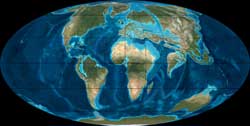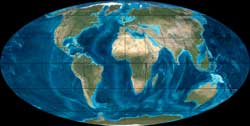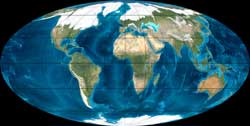The Cenozoic Era

|
|
Global paleogeographic reconstruction of the Earth in the Eocene system 50 million years ago.
(Courtesy Dr. Ron Blakey) |

|
| Global paleogeographic reconstruction of the Earth in the Miocene system 20 million years ago. (Courtesy Dr. Ron Blakey) |

|
| Global paleogeographic reconstruction of the Earth in the Pleistocene system 50,000 years ago. (Courtesy Dr. Ron Blakey) |
The Cenozoic era, meaning "new life" is also known as the Age of Mammals, just as the Mesozoic era was the Age of Reptiles. The Cenozoic spans the time period covered from the final extinction at the end of the Cretaceous, approximately 65 million years ago, to the present. The Cenozoic era is divided into three periods, and seven systems:
| Paleogene (65-23 Ma) | ||
| Paleocene Eocene Oligocene | (65.5 Ma — 55.8 Ma) (55.8 Ma — 33.9 Ma) (33.9 Ma — 23.03 Ma) | |
| Neogene (23-2.5 Ma) | ||
| Miocene Pliocene | (23.03 Ma — 5.33 Ma) (5.332 Ma — 2.588 Ma) | |
| Quaternary (2.5 Ma-present) | ||
| Pleistocene Holocene | (2.588 Ma — 12,000 years) (12,000 years — present) | |
During the Paleogene period the climate was tropical much like the Mesozoic. During the Neogene period, however, the earth cooled. Certain changes in the water currents formed as a result of South America joining with North America. This cooled the Arctic and, combined with other factors, created the most recent Ice Age. After time, however, the ice melted and the climate began to be much as we know it today. The three periods saw the domination of Mammals on the earth and the evolution of mankind. The Cenozoic is the age in which we live.
Tectonics
During the Cenozoic era the continents moved to their modern positions. India collided with Asia in a high speed collision that caused so much geological stress that it raised the largest mountain range currently known to man, the Himalayas. Antarctica moved to the south pole, and South America slowly attached itself in a cushioned low-speed collision with North America forming the Isthmus of Panama. North America continued separating form Europe widening the Atlantic ocean. Arabia collided with Eurasia in a low-speed collision closing the Tethys ocean.
Life
Marine life in the Cenozoic began much as it is today. Land animals and birds continued evolving. Near the beginning of the Cenozoic the world was dominated by birds, crocodiles, and only a few mammals. It was later that mammals began to thrive and diversify intensely. Birds still outnumbered mammals significantly, making it appear that the dinosaur still had their hold on the world. However, the land was now dominated by mammals. The Neogene period saw a rise in savannas, flowers, and perhaps most importantly, grass. The grass created a change in mammal evolution. Mammals similar to horses, cows, and other grazers appeared. It was late in the Cenozoic that modern man or Homo sapiens began to populate the earth. There are several conflicting theories on the origin of man. Human ancestors may have evolved around 1 million years ago. The species Homo sapiens was probably formed by 50,000 years ago. However, it isn't until about 6,000 years ago that evidences such as a written language and cities began to form and humanity began to grow into what it has now become.
| Proterozoic eon |
542 Ma - Phanerozoic eon - Present | |||||||||||
|---|---|---|---|---|---|---|---|---|---|---|---|---|
| 542 Ma - Paleozoic era - 251 Ma | 251 Ma - Mesozoic era - 65 Ma | 65 Ma - Cenozoic era - Present | ||||||||||
| Cambrian | Ordovician | Silurian | Devonian | Carboniferous | Permian | Triassic | Jurassic | Cretaceous | Paleogene | Neogene | Quaternary | |